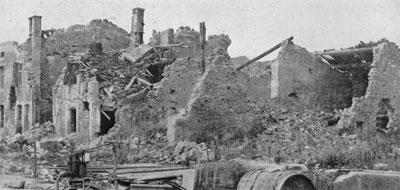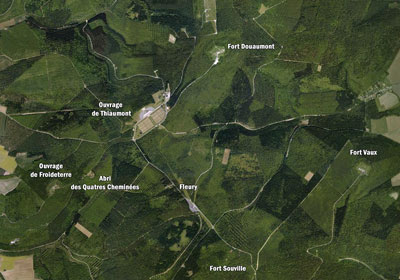
WWII: Maginot Line | Normandy | V-Weapon Sites | Arnhem
Further afield: Crete
| Home Tracing Military Ancestors Travel Advice CWGC Cemeteries Iron Harvest News Book Reviews Glossary Links Contact Me Verdun:
 
|
Crisis of the BattleBuoyed by the progress made on the left bank, Falkenhayn agreed to a further major attack on the right where progress had been painfully slow since early April. This time a co-ordinated five-division assault would take Forts Vaux and Souville and the redoubt known as the Ouvrage de Thiaumont, smashing open the northern approaches to the city.
The German attack, codenamed "May Cup", began on 1st June. Despite a heroic defence that latest nearly a week, Vaux was forced to surrender on 7th June. Meanwhile, at Thiaumont, at one of the highest points of the ridge (near where the Ossuary now stands), one of the most bitterly fought engagements of the entire battle was contested. The Ouvrage was to change hands no less than 16 times between 8th June and 24th October as both sides fought for control of the Côte de Froideterre between Fort Douaumont and the Meuse.
With fighting all along the line, von Knobelsdorf made one last supreme effort to crush the French defences on the Hauts de Meuse. On 23rd June, preceded by a two-day bombardment which included deadly "Green Cross" phosgene gas shells for the first time, 17 German regiments were thrown at the Thiaumont – Fleury – Souville front. For a moment, the onslaught threatened to break through. German soldiers swarmed over the glacis and barrack block of the Ouvrage de Froideterre and were only finally driven off by a grenade and bayonet charge. Nearby they moved down the ridge to threaten the Abris de la Quatre Cheminée. Further east, they gained a foothold in the village of Fleury and made it to the outer works of Fort Souville. But everywhere French counter-attacks sealed off the gains. On 11th July, in one last desperate effort to break through, some German soldiers actually made it onto the glacis of Fort Souville from where the spires of the cathedral in Verdun could be glimpsed, before they were killed or captured at the point of the bayonet. It was the highpoint of German ambitions. A week later the Allied offensive on the Somme began and the Germans were forced to bring an end to the Verdun offensive. General Nivelle's closing words in his Order of the Day for 23rd June summed up the battle for the French, "Ils ne passeront pas!" – "They shall not pass". No German soldier did.
prev page (Le Mort Homme and Approaches to Fort Vaux) | next page (French Counter-Offensives and Aftermath)
|

